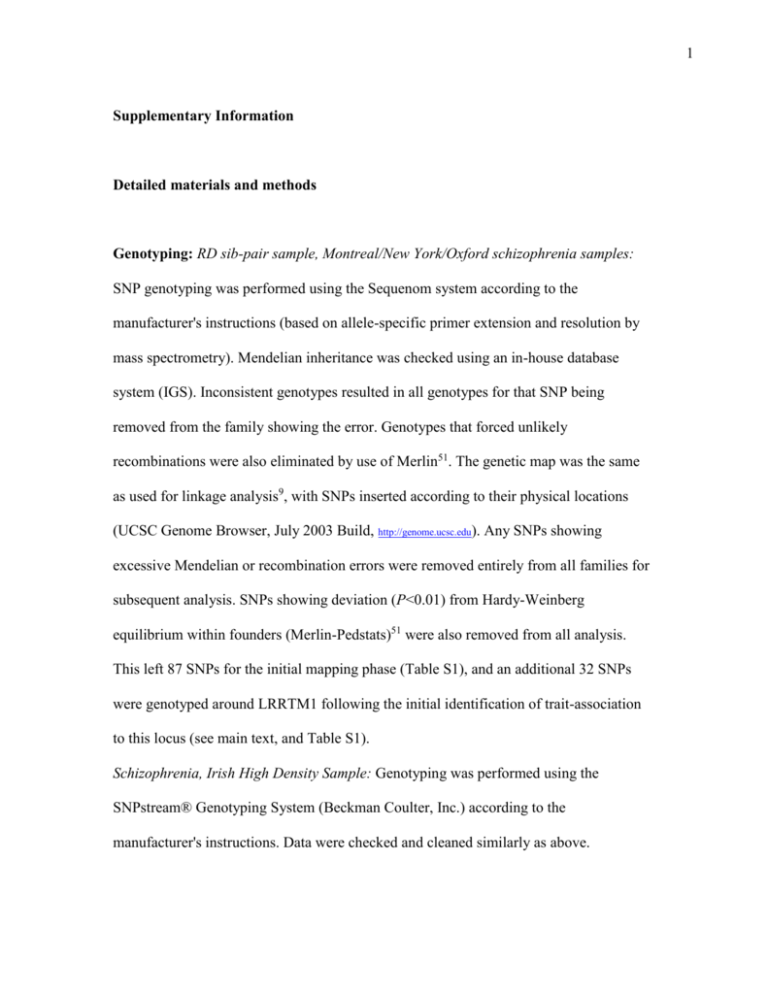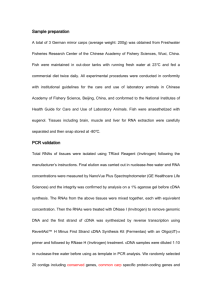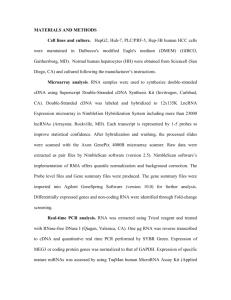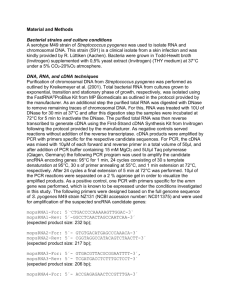Supplementary Information (doc 86K)
advertisement

1 Supplementary Information Detailed materials and methods Genotyping: RD sib-pair sample, Montreal/New York/Oxford schizophrenia samples: SNP genotyping was performed using the Sequenom system according to the manufacturer's instructions (based on allele-specific primer extension and resolution by mass spectrometry). Mendelian inheritance was checked using an in-house database system (IGS). Inconsistent genotypes resulted in all genotypes for that SNP being removed from the family showing the error. Genotypes that forced unlikely recombinations were also eliminated by use of Merlin51. The genetic map was the same as used for linkage analysis9, with SNPs inserted according to their physical locations (UCSC Genome Browser, July 2003 Build, http://genome.ucsc.edu). Any SNPs showing excessive Mendelian or recombination errors were removed entirely from all families for subsequent analysis. SNPs showing deviation (P<0.01) from Hardy-Weinberg equilibrium within founders (Merlin-Pedstats)51 were also removed from all analysis. This left 87 SNPs for the initial mapping phase (Table S1), and an additional 32 SNPs were genotyped around LRRTM1 following the initial identification of trait-association to this locus (see main text, and Table S1). Schizophrenia, Irish High Density Sample: Genotyping was performed using the SNPstream® Genotyping System (Beckman Coulter, Inc.) according to the manufacturer's instructions. Data were checked and cleaned similarly as above. 2 Schizophrenia, Han Chinese sample: Genotyping was performed using TaqMan® Pre-Designed SNP Genotyping Assays (Applied Biosystems) and ABI 7900 instrument, and by following manufacturer's instructions. Data were checked and cleaned similarly as above. Schizophrenia, Afrikaner sample: Genotyping was performed at the Center for Inherited Disease Research, http://www.cidr.jhmi.edu/, using the Illumina platform. Data were checked and cleaned similarly as above. Schizophrenia, Munich and Aberdeen case-control samples. The genotyping was performed using the Illumina Infinium assay. Raw data were re-checked for genotyping quality. Brisbane Twin Sample: Genotyping was performed using the Sequenom iPLEX™ system according to the manufacturer’s instructions. Data were checked and cleaned similarly as above. Association analysis: Handedness. We used QTDT18 to perform paternal-specific single-marker association analysis with relative hand skill in 222 siblings, using genotype data from parents to establish parent-of-origin. Rather than using the in-built paternalspecific option in QTDT, we first generated best-fit haplotypes for all individuals using Merlin51, and then used the paternally-inherited allele for each SNP (in cases where phase could be assigned) as a binary covariate in a variance component (VC) model that also included a grand mean with polygenic, QTL-specific, and unshared environmental VCs. The likelihood of the model including the paternally inherited allele as a covariate was compared with the likelihood without this covariate for each SNP, for a chi-square significance test with one degree of freedom. This approach has the advantage that it uses 3 sibling multipoint identity-by-descent estimation to obtain extra information on parental allelic origin in situations that are otherwise ambiguous (i.e. where both parents and a child are heterozygous). As linkage is modelled explicitly by variance components, the association test is unbiased in the presence of linkage. For analysis of haplotypes, we used together the in-built options in QTDT for paternalspecific, total and multi-allelic analysis. For this analysis the haplotypes were again estimated with Merlin, and where phase could be resolved the haplotypes were recoded as individual "alleles", and then used as input to QTDT. In this analysis the full model includes separate mean effects for all haplotypes simultaneously, and is compared to a model that includes no haplotype effects (just a grand mean and variance components as above). There was therefore only a single test for each set of haplotypes defined by a specific set of SNPs, and this reduced multiple testing. In follow-up analysis of the positive result upstream of LRRTM1, we modelled individual haplotype effects one-at-atime versus all others, in order to gauge the contribution of individual haplotypes. We used the same approach to test a proxy (see below) of the LRRTM1 ‘risk’ haplotype for association with relative hand skill in a sample of 354 pseudo-independent normal sibpairs from 215 twin-based families from Brisbane, Australia52 (based on the SNPs rs1007371, rs723524, see fig S1). Association analysis: Schizophrenia. Families: We generated haplotypes as above, and where phase could be assigned the haplotypes were recoded as individual "alleles", and then used as input to 'SIB_TDT' within the package ASPEX http://watson.hgen.pitt.edu/docs/usage.html, using the 'sex-split' option to 4 test paternal and maternal transmission separately. We did not use inferred haplotypes for individuals from whom genotype data were missing. Furthermore, SIB_TDT is conservative and scores transmission only in unambiguous situations, with no inference. Non-independence within affected sib pairs is accounted for by permutation to derive empirical significance levels. For the case-control populations we used Haploview 3.32 to test for haplotypic association using the default settings, using the SNPs rs1446109 and rs17019074 (the latter is equivalent to rs723524 for tagging the haplotypes of interest (see below), according to international HapMap data). Case-control: Given the rarity of the risk haplotype in European populations, we combined the Munich and Aberdeen case-control samples for a single test of association, analyzed with logistic regression using a flexible genotypic model with two degrees of freedom, with covariates for sex and the collection site, using the software PLINK (http://pngu.mgh.harvard.edu/~purcell/plink/). Mutation screening: To screen for polymorphisms within and close to LRRTM1, we used denaturing high performance liquid chromatography (DHPLC), followed by direct dideoxy sequencing. DHPLC was performed using the WAVE™ system (Transgenomic), according to the manufacturer’s instructions, and data were analyzed with the WAVEMAKER software. Cell lines and tissues for imprinting analysis: Hybrid cells were maintained at 37˚C, 5% CO2 in DMEM supplemented with 10% calf serum and 800 µg/ml GENETICIN 5 (Gibco BRL, Rockville, MD, USA). EBV-transformed lymphoblast cultures were maintained at 37˚C, 5% CO2 in RPMI 1640 (Gibco BRL) supplemented with 10% fetal calf serum. In Oxford, 24 non-tumor human brain tissues were used for extraction of total RNA and genomic DNA. In Tottori, 12 non-tumor human brain tissues were used for extraction of total RNA and genomic DNA. In Tallinn, 8 unrelated post mortem human brains were identified that were informative for LRRTM1 expression analysis, and 5 for CTNNA2. In Leipzig, 2 unrelated post mortem chimpanzee brains were identified as informative for LRRTM1 and used for extraction of total RNA and genomic DNA. All samples were acquired with the approval of the appropriate ethical committees. PCR-based polymorphic analysis of A9 hybrids: PCR amplification was performed to detect the region of human chromosome 2 that was contained in mouse A9 hybrids using primer pairs for the proopiomelanocortin (POMC), gamma-glutamyl carboxylase (GGCX), transcription factor 7-like 1 (TCF7L1), BCL2-like 11 (BCL2L11), v-ral simian leukemia viral oncogene homolog B (RALB), distal-less homeo box 1 (DLX1), and STS marker D2S293. Primer sequences and reaction conditions are available on request. PCR analysis of a polymorphic marker, D2S337, was used to determine the parental origin of human chromosome 2 in mouse A9 hybrids. Expression analysis for imprinting: Tottori: Total RNA samples, extracted from all cultured cells and tissues using the RNeasy Mini Kit (QIAGEN, Bethesda, MD, USA) according to the manufacturer’s instructions, were treated with RNase-free DNase I (NIPPON GENE, Tokyo, Japan). First strand cDNA synthesis was performed with (RT+) 6 or without (RT-) M-MLV reverse transcriptase (Gibco BRL) using an oligo (dT)15 primer (Promega, Madison, WI, USA). As a control, integrity of RNA was assessed by amplification of mouse and human glyceraldehyde-3-phosphate dehydrogenase (GAPDH) genes as described previously.53 RT-PCR was performed on the synthesized cDNA or Human Multiple Tissue cDNA (MTC) Panels (Clontech) with Taq GOLD polymerase (Perkin Elmer, Foster, CA, USA). For imprinting (or monoallelic expression) analysis of LRRTM1, cDNA samples synthesized from normal human lymphoblastoid cell lines and non-tumor brain tissues were amplified using the primers flanking C/T and C/G polymorphisms (at nt 87965 and 88009 of GenBank acc. AC016670). PCR amplification of genomic DNA or cDNA was performed, and PCR products of lymphoblast samples and non-tumor brain tissues were purified and sequenced directly from both directions using the Dye terminator sequencing core kit (PE Applied Biosystems, Warrington, UK). Sequencing was performed on an ABI3700 automated sequencer. The expression of LRRTM1 in mouse A9 cells, human fibroblasts and mouse A9 hybrids were also analysed. We tested cerebral cortex, cerebellum, brain stem, olfactory bulb, thymus, heart, lung, liver, intestine, pancreas, spleen, kidney, muscle, and testis of two reciprocal crossed F1 mice between C57BL/6J and JF1 strains for allele-specific expression. Each of the F1 mice was 30 weeks old. Expression of Lrrtm1 was detected in cerebral cortex, cerebellum and brain stem. cDNA samples were amplified for 26 cycles by PCR primers flanking the following polymorphic sites: C/T poymorphism at 56323bp on genomic clone AC121356, A/G poymorphism at 69272bp on AC121356, C/T polymorphism at 69302bp on AC121356. 7 Oxford: Genomic DNA and total RNA were extracted from 24 post mortem non-tumor human brain tissues according to standard protocols, and the LRRTM1 transcribed SNP rs6733871 was genotyped by PCR/RT-PCR followed by allele-specific digestion with DdeI and agarose gel eletrophoresis (primer sequences and reaction conditions are available on request). Tallinn: LRRTM1 imprinted expression was tested similarly as in Oxford, but from many different brain regions (details available on request). Leipzig: The third exon of LRRTM1 was sequenced in five chimpanzees for which brain samples were available. A SNP was identified in two individuals (C/T polymorphism at position chr2a:82,045,147 in chimpanzee March 2006 assembly), from which total RNA was isolated from a cortex sample. Biallelic expression was determined by RT-PCR and sequencing (details available on request). Methylation analysis: Genomic DNA samples from post-mortem brain samples were treated with sodium bisulfite using the CpGenome DNA Modification Kit (INTERGEN, Purchase, NY, USA) according to the manufacturer’s instructions. PCR was performed on modified DNA in which cytosine was converted to uracil. Amplified PCR products were separated and isolated from a 2% agarose gel using the Qiaquick gel extraction kit and directly sequenced as described above. We examined a total of 26 CpG sites in CpG island 1, and 38 CpG sites in CpG island 2. To assess methylation we used also a Sequenom modified protocol developed to detect DNA methylation in CpG islands and based on the MassCLEAVE method for the detection of novel SNPs (Introduction to DNA Methylation Analysis Using the MassARRAY System 8 54 http://www.sequenom.com/depts/qa/Document/Application%20Notes/Methylation%20Analysis/8876-007.pdf. Briefly, amplification was carried out using tailed primers, then the PCR products obtained were processed using the Sequenom MassCLEAVE transcription protocol, followed by C and T specific RNAse cleavage reactions. Samples were conditioned according to manufacturer instruction and run on MALDI-TOF using the Autoflex mass spectrometer and mass spectra were analyzed using the SNP discovery (Sequenom, San Diego, USA), and in parallel specially designed software.55 Working on the reverse strand methylation was detected as a G/A polymorphism, where G corresponded to a methylated C protected from bisulfite conversion on the forward strand, and A to no methylation. Subcellular localisation Oxford: Mouse LRRTM1 protein, untagged or with C-terminal [myc + 6xHis] tags, was over-expressed in mammalian cells using plasmids pcDmL1 and pcDmL1m, respectively, containing the full-length mouse LRRTM1 cDNA cloned into pcDNA4-TO-mycHisA vector (Invitrogen).MRC-5 SV2 cells (SV40-transformed human foetal lung fibroblasts) were grown on coverslips in 24-well tissue-culture plates, in Dulbecco’s modified Eagle medium (DMEM) supplemented with 10% Foetal Bovine Serum, 2mM L-Glutamine and 100 U/ml penicillin/streptomycin at 37 ºC with 5% CO2. Cells were transfected with 0.5µg of plasmid per well using GeneJuice (Novagen) as transfection reagent according to manufacturer’s instructions; medium was changed 4-8 hours after transfection. Cells were grown as described above for 24-36 hours, washed with PBS, fixed for 30 min with 3% paraformaldehyde in PBS at room temperature, washed 5x with around 1ml IF solution (0.1% Triton X-100 in TBS) and used for indirect immunofluorescence 9 experiments. Cells were incubated for 1 hour with antibodies diluted in IF block solution (0.1% Triton X-100 in TBS + 10 mg/ml fish gelatine) and then washed 5x with IF washing solution. Coverslips were mounted on to microscope slides and examined using a Zeiss LSM510 META Confocal Imaging System. Polyclonal antisera against LRRTM1 were obtained by Eurogentec (Seraing, Belgium) after immunization of rabbits with both peptides “126” (LVDGGEGHDGTFEPIC, positions 395 to 409) and “127” (CFVTQRRKQKQKQTMH, positions 463 to 478); specific anti-peptides were purified by affinity chromatography against each of the mentioned peptides. Anti-peptide 126, but not 127, was proved to specifically detect LRRTM1 (data not shown). Mouse monoclonal antibody A1/182 against BAP31,56 kindly provided by Dr. Hans-Peter Hauri (Basel, Switzerland), was used as an ER marker. Alexa-Fluor 488 (green) goat anti-mouse and 594 (red) goat anti-rabbit (Molecular Probes) were used as secondary antibodies. Yale: Dorsal root ganglia (DRG) isolated from one 3-5 weeks old rats were digested with collagenase and dispaseII, triturated, nucleofected according to manufacturer's instructions (Amaxa GmbH), and cultured in Neurobasal-A media supplemented with 10% FCS, 2mM L-glutamine and 100 nM NGF on poly-L-lysine and laminin coated slides. Mouse E17 cortical cell cultures were transfected with Lipofectamine 2000 (Invitrogen), resulting in solitary transfected neurons. Neuro-2a and Cos-7 cells (ATCC) where cultured in DMEM supplemented with 10% FCS, 2 mM L-glutamine and penicillin-streptomycin, and transfected with Fugene6 (Roche). Mouse LRRTM1 and Lingo1 expression vectors were prepared by standard molecular biology techniques. The final constructs contain Ig ĸ signal peptide and myc and 6xHIS tags, followed by LRRTM1 or Lingo1 open reading frame devoid of signal peptide, cloned into XbaI 10 restriction site created to replace stop-codon in original pSecTag2a plasmid (QuikChange II Site-Directed Mutagenesis Kit, Stratagene) . All constructs were sequenced to confirm that no unwanted changes occurred. ER-marker dsRED2-ER vector was from Clontech. All immunostainings were done 40 hours after transfection. Cells were fixed, permeabilized and stained with anti-myc antibody (Santa Cruz biotechnology, Santa Cruz, CA), and neurons were visualized with anti beta-tubulin antibody (Covance, Princeton, NJ). Alexa Fluor 488 goat anti-mouse and 568 goat anti-rabbit secondary antibodies (Invitrogen) were used. For live-cell stainings cells were incubated in HBSS with alkaline phosphatase conjugated anti-myc antibody (9E10; Sigma) at room temperature or at +4°C for 1 hour, washed, fixed with 4% PFA, incubated 2 hours at 65ºC to block endogenous phosphatases, and developed using BCIP/NBT reagents. Live-cell staining resulted in 20-30 strongly stained DRG neurons per well for myc-Lingo1 but none for myc-LRRTM1. In situ hybridisation Mouse: Coronal sections from fresh-frozen adult mouse brain and sagittal sections of PFA-fixed E12 and E15 mouse embryos were analyzed by in situ hybridization with Lrrtm1 riboprobes as described previously.35 Human: In situ Hybridization was performed as described previously Easterday et al. Dev Biol. 2003 Dec 15;264(2):309-22; Abu-Khalil, Fu et al. J Comp Neurol. 2004 Jun 21;474(2):276-88. Gene-specific probes for LRRTM1 (Genbank NM_178839.4, see below) were amplified by PCR and cloned into pCR II (Invitrogen, Carlsbad, CA). In vitro transcription was then 11 performed to generated S35- labeled antisense cRNA. Labeled probe was hybridized onto 20 μm frozen tissue, sectioned in the coronal plane, and opposed to autoradiography films. Results were consistent for two LRRTM1-specific probes. No signal was observed following hybridization of a labeled sense probe. Probes: pBSA116 oBSA526/527 PCR product (459 bps) in pCRII-TOPO vector. Corresponds to human LRRTM1 (GenBank Accession NM_178839.4) Product spans intron (chr2:80384144-80384874) and runs bps 125 through 582 Specific by BLAT. 061107; JVP. Sequence Good For sense probe cut with Kpn1 and transcribe with T7 For antisense probe cut with Xho1 and transcribe with SP6 pBSA117 oBSA528/259 PCR product (430 bps) in pCRII-TOPO vector. Corresponds to human LRRTM1 (GenBank Accession NM_178839.4) Product not intron spanning and runs bps 625 through 1035 Specific by BLAT. 061107; JVP. Sequence Good For sense probe cut with Xho1 and transcribe with SP6 For antisense probe cut with Kpn1 and transcribe with T7 Northern analysis Human Multiple Tissue Northern (MTN) Blots II and V (BD Biosciences) were probed at 42 ºC using formamide, according to standard procedures. To obtain LRRTM1 probe, a PCR 12 fragment corresponding to bases 895 to 1567 of human LRRTM1 cDNA (1165 to 1837 in GenBank clone BC045113) was amplified with AmpliTaq Gold DNA polymerase (PE Applied Biosystems) using a BamHI fragment of plasmid pBEhL2-B5 (LRRTM1 full-length cDNA cloned into pBluescript) as a template. Human -Actin cDNA control probe was supplied with the MTN blots. Probes were labeled with [32P]-dCTP using the Megaprime DNA labeling system (Amersham Biosciences) according to manufacturer’s instructions. Quantitative PCR from left and right rodent forebrain Oxford, mice: The morning when the vaginal plug was detected was defined as embryonic day 0.5 (E0.5). At E14.5 left and right forebrain hemispheres of 11 embryos from 2 litters were dissected in ice-cold dissection buffer (15mM HEPES, NaHCO3, 25mM Glucose in HBSSCMF). Meninges were removed and tissue samples were immediately homogenized in TRIzol (Invitrogen) using a Dounce homogenizer. Total RNA was extracted using standard procedures followed by cleanup with RNeasy columns (QIAgen). First-strand cDNA was synthesized from 2µg total RNA using Superscript III reverse transcriptase (Invitrogen) and random hexamers as primers. Relative quantification of cDNA was performed by real-time quantitative PCR with iQ SYBR Green Supermix (BioRad) on a BioRad iCycler instrument using the 60s ribosomal subunit for normalisation. After an initial incubation for 3 min at 95°C, PCR was performed. Tallinn, rats: LRRTM1 mRNA levels were measured in the right and left hippocampus of 12 adult Wistar rats using quantitative real time PCR (protocol available on request).







